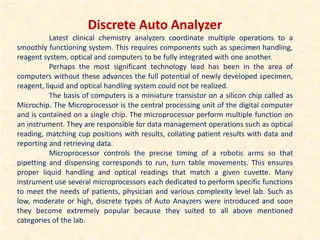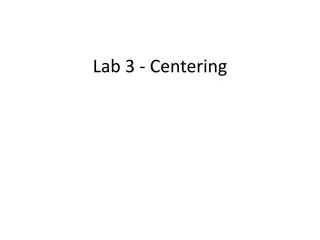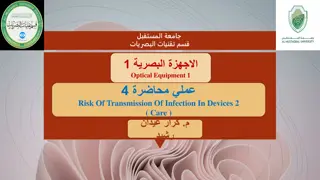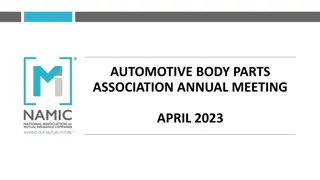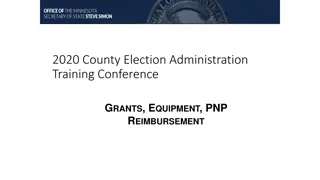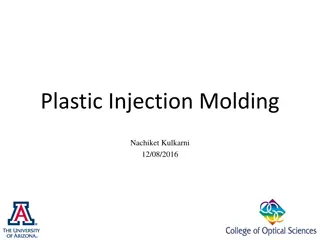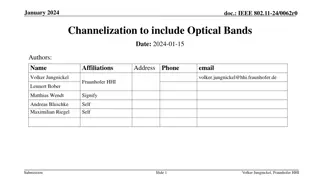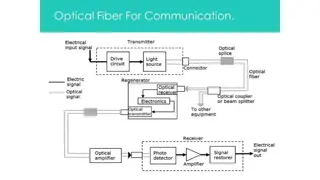Understanding Auto-refractors in Optical Equipment
An auto-refractor is an automated system that uses light reflected off the retina to measure a patient's refractive error objectively. This technology is fast, safe, and easy to use, providing accurate prescriptions without the need for pupil dilation. While children may find it challenging to sit still for long periods during the test, the auto-refractor is an essential tool for detecting refractive errors like myopia, hyperopia, astigmatism, and squints. The device consists of various components like LCD screens, control buttons, and fixation targets. However, it may have limitations in cases of poor fixation or certain eye conditions. Understanding the indications and contraindications of auto-refractors is crucial for effective eye care.
Download Presentation

Please find below an Image/Link to download the presentation.
The content on the website is provided AS IS for your information and personal use only. It may not be sold, licensed, or shared on other websites without obtaining consent from the author. Download presentation by click this link. If you encounter any issues during the download, it is possible that the publisher has removed the file from their server.
E N D
Presentation Transcript
2 Introduction
/ . Auto refractor : An automated system that uses a source of light reflected off of the retina to reveal the eyes refractive characteristic Auto refractor provides an objective measure of a patient s refractive error detect . 3
/ . It's easy to see how light affects eye movement. It's fast, safe, and easy. Many pieces of data are recorded, and an average is given. Doesn't need the pupil dilation. Advantages It is possible to print out the prescription. 4
/ . Children can't stay still for long periods of time. Because of accommodations, reading is not correct. Big size of the auto refractor disadvantages Want to be set up on a table. 5
/ . Different signs can show in a patient that they have a refractive mistake. These signs and symptoms are: - Blurred/distorted vision Indications - Myopia. - Hyperopia. - Astigmatism. - Squint of the eyes - Contact lens prescription. 6
/ . LCD screen, Measure button Control stick, Stick locker Moving part, Base Parts Function switches Forehead-rest Measuring window, Chin-rest Chin-rest knob, Limit screw Power switch, Power cord. 7
/ . There are three key parts to the auto-refractometer:: - an infrared light source - a fixation target Main Components - Badal lens system ( fogging lens). 8
/ . poor fixation. corneal, lens and media opacities. Small pupil or a distorted pupil. Sources of Error accommodating variations, creating 'over minus' readings. 9
/ . Patients with mental disabilities Patients suffering from severe poor vision Severe traumatic ocular injury Contraindications Conjunctivitis, keratitis, uveitis, episcleritis corneal edema Artificial prosthesis Very small children Patients presenting with accommodation anomalies 10
/ . - The patient should be educated regarding how to get seated on the instrument. - the patient should be explained the procedure and the importance of autorefractometry. - The patient should be told to remove glasses or contact lenses Procedures before performing the investigation. - The patient should be explained to keep the arms on the table, chin on the chinrest, and head should rest against the forehead rest. Then the chin adjustment should be made to align the visual axis. The height can be moved up and down with a height adjustment knob. - Each step should be explained to the patient while operating the autorefractor. 11
/ . - The patient should be told that they will observe a hot air balloon. - The fine horizontal alignment is performed by moving the joystick right and left and vertical up and down to get a Procedures proper focus. - The patient should be told to relax once they see the target. - After completing the investigation, the patient should be complemented for good cooperation and told to take another seat and relax. - then examined to check visual acuity and prescribed a prescription. 12
/ . There are no risks or complications associated with Risks & this test. Complications 13







